DIY Modern Barn Door (Diagram Included!)
We designed a modern barn door for way less than retail cost. If you want to add a sliding barn door and are unsure whether to DIY or buy, see our “why,” “what,” and “how” below. There are detailed diagrams to follow step-by-step if you decide to replicate!

This site contains affiliate links to products. We may receive a commission for purchases made through these links.
My handsome, handyman husband recently designed and custom-built a modern barn door for way less than retail cost.
This DIY barn door is not any ordinary door seen in many farmhouse-styled homes, either. Abstract, artistic, and asymmetrical, it’s a beautiful behemoth that demands admiration.
Not to mention, it provides adequate privacy for our master bathroom now, too.
If you want to add an interior sliding barn door and are unsure whether to DIY or buy, I’ve put together our “why,” “what,” and “how” below.
Read to the end for detailed diagrams to follow step-by-step if you decide to replicate this custom design!
Reasons to Install an Interior Barn Door
We had a few reasons for designing and building our own modern, sliding barn door.
First of all, our master bedroom sits at an angle, adjacent from our main entrance. French doors open to our room and then an archway conjoins from our master bathroom. Anyone passing by these French doors can see us standing at the vanity or even soaking in the tub.
While I love the openness of my home, I also think privacy is necessary at times.
Besides, all that exposed air causes a chilly draft while bathing. Hello, unwanted goose pimples.
Our final reason for wanting a sliding barn door for our bathroom might seem a petty one. What can I say? I’m not a morning person.
Our bedroom is southeast facing, meaning early morning light is a given. To cut down on those awake-before-the-alarm-clock days, we knew a sliding barn door was a must.
Why DIY a Modern Barn Door?
I quickly discovered main hardware stores like Home Depot and Lowe’s only offer sliding barn doors in standard door frame sizes.
If you live in a southwest home, though, especially one built circa early 2000s, most main rooms and master bathrooms are taller and arched due to vaulted ceilings.
Basically, a 36” x 84” barn door would leave an awkward gap. This method would inevitably require more DIY jerry-rigging because I would not be able to handle that level of tackiness.
Once we realized we needed a custom barn door, I headed over to OfferUp and Craigslist. I thought I’d find someone who either built and sold sliding barn doors or had parts and pieces for purchase.
I found some, alright. Most wanted to charge $600 minimum for the door size we needed. That was just the basic design you see in most homes and store ads. The estimated price didn’t include the hardware to mount our door, either.
The more we discussed it, the more I realized I wanted something unique. The farmhouse look is amazing, but I had a modern, eclectic vision in mind.
Yes, I love the natural wood elements in home design these days. I even like the white paint trend, in moderation. But I also like pops of color or pattern that become a statement piece. I like articles of furniture that inspire creativity or, in the very least, conversation.
And so, with the words that spark all our DIY home ideas, I said: “Might as well make our own and save the cash.”
So, we did.
How to Design a Sliding Modern Barn Door
Crack your knuckles and bust out your tape measure, folks.
When jotting down dimensions for your barn door, allow for an inch or two extra to overlap your door frame. If you measure to just fit the frame width, it may appear too short or narrow. Most interior wall structures are not perfectly straight to begin with. Allowing for overlap on both sides and the top will take care of that.
For example, our sliding barn door needed to be 92” high x 40” wide to cover our 90” x 38” arched door frame.
Thus, one sheet of plywood was more than enough for the door itself. Andrew cut this down to the correct measurements and created a border for his design using a table saw. But we ripped (AKA cut) the slatted, geometric pieces from the original sheet’s remnant using a miter saw.
A good reason to cut these 2-inch-wide diagonal strips from the same type of plywood (even if you need another sheet) is to ensure they aren’t warped. Solo lumber pieces run the risk of becoming warped and bent from environmental factors.
Once all cuts were complete, he used a spacer to lay out these diagonal pieces within the border. One piece at a time, he pre-drilled all holes and drilled in screws.
While it is tedious, it is best to add these pieces to our modern barn door one at a time. Just a fraction off and the design won’t work!
After every piece was secured, wood putty was applied over all screw holes. Although it really only requires a couple hours to dry, we let it sit overnight. Then we took a light sanding sponge to any rough edges that formed after the putty hardened.
To prime and paint, I laid the modern barn door on top of two floor furniture dollies. I threw some old towels under it, then opened my can of Kilz primer and got to work with my paintbrush. This stage requires cautious, soft brushstrokes so brush lines aren’t visible when it dries.
Every tiny edge and corner proved difficult to coat. After about two hours of dry time, though, I was itching to paint.
I rolled as much of the flat surfaces as possible to get a smooth, consistent look. Any narrow area or crevice (shudder) required a paintbrush.
Tip: it was easier to add the industrial barn door handle while it was flat.
In the meantime, Andrew mounted an 8ft board to the wall above our bathroom door frame to use as an anchor for our sliding barn door rail. The directions for the barn door hardware kit were self-explanatory (not that he read them).
Last, we propped the freshly painted, 100lb barn door up along the rail system. Andrew bolted it to the rail’s brackets.
We gently let it hang, then stepped back to admire our handiwork.




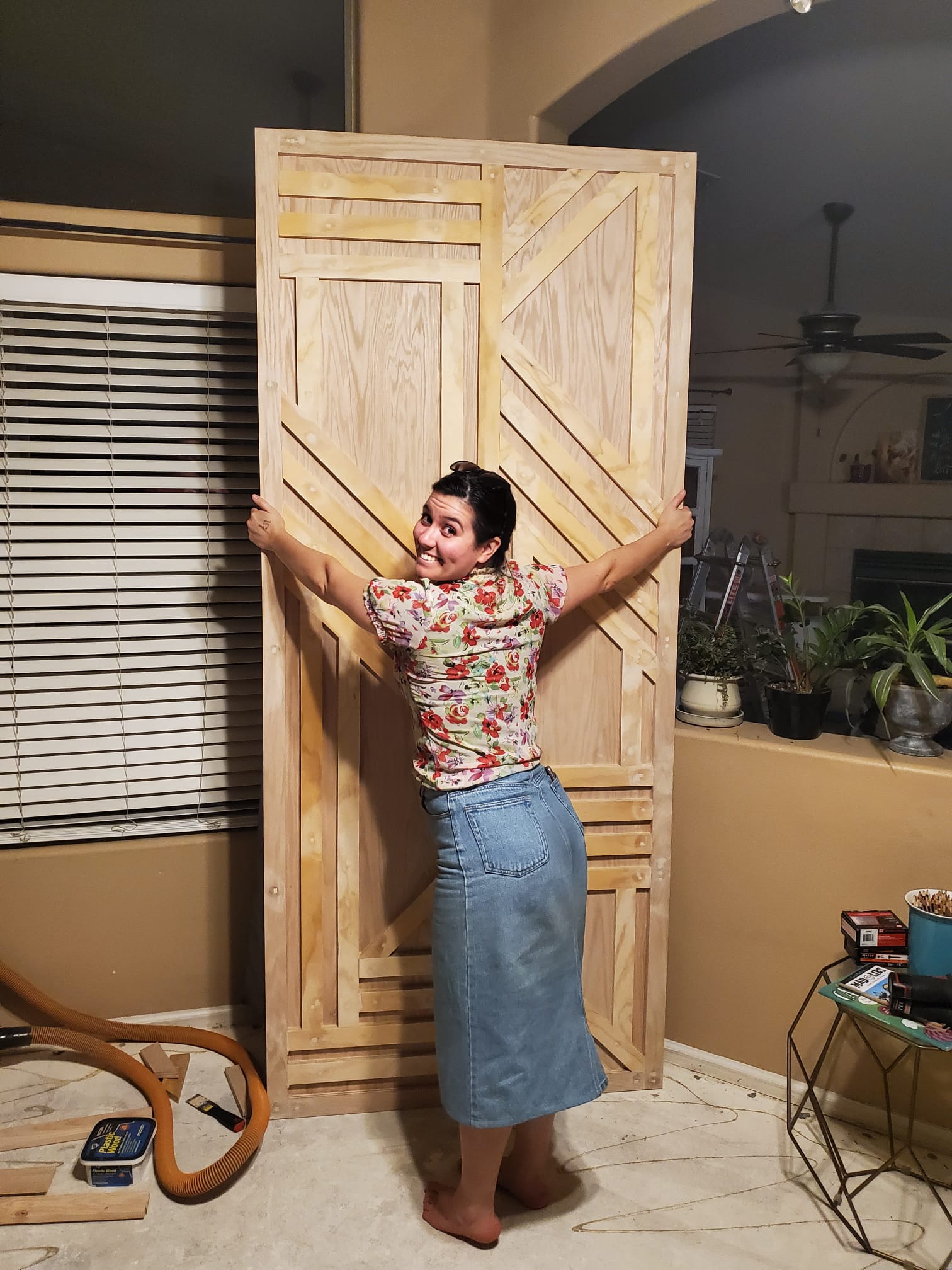
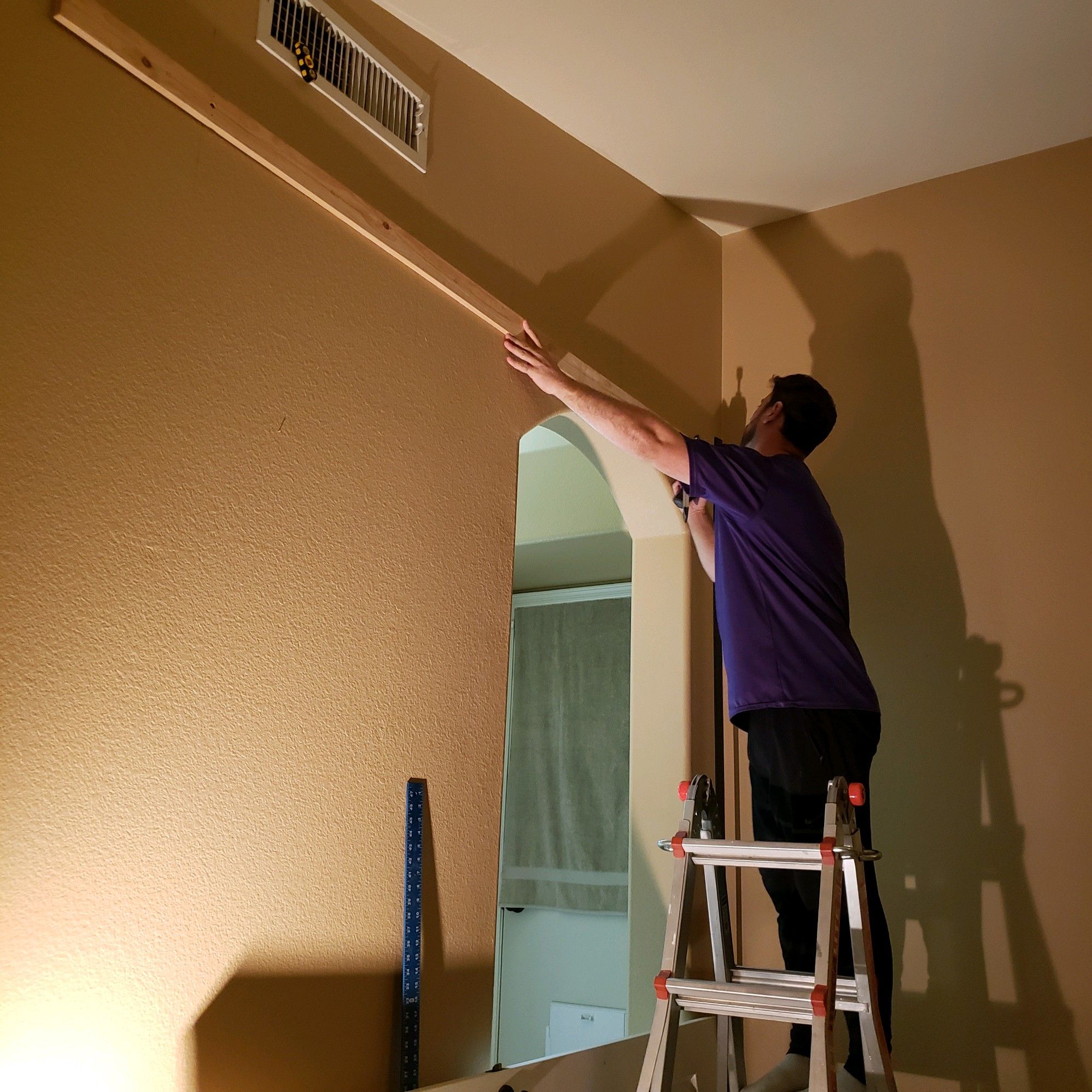

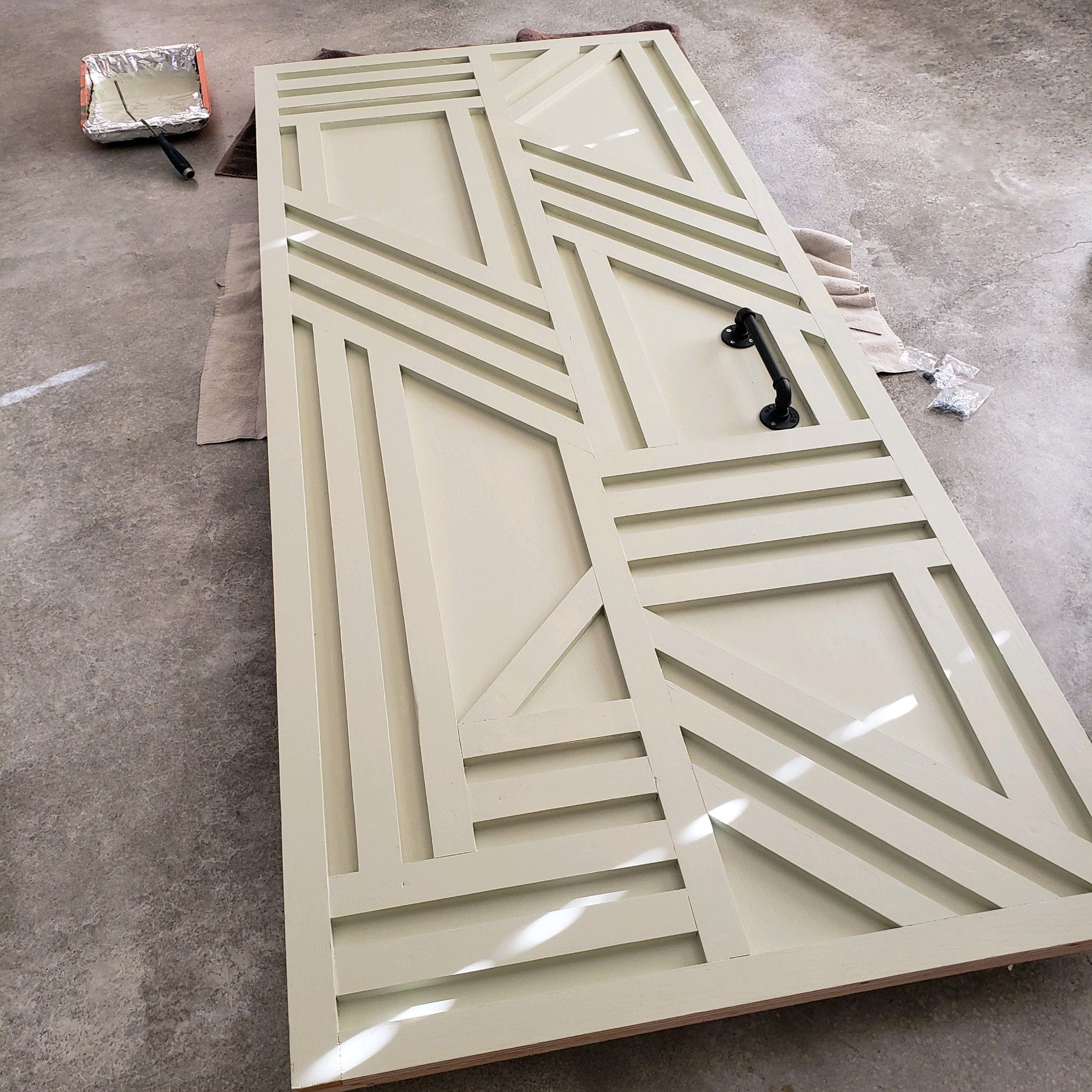
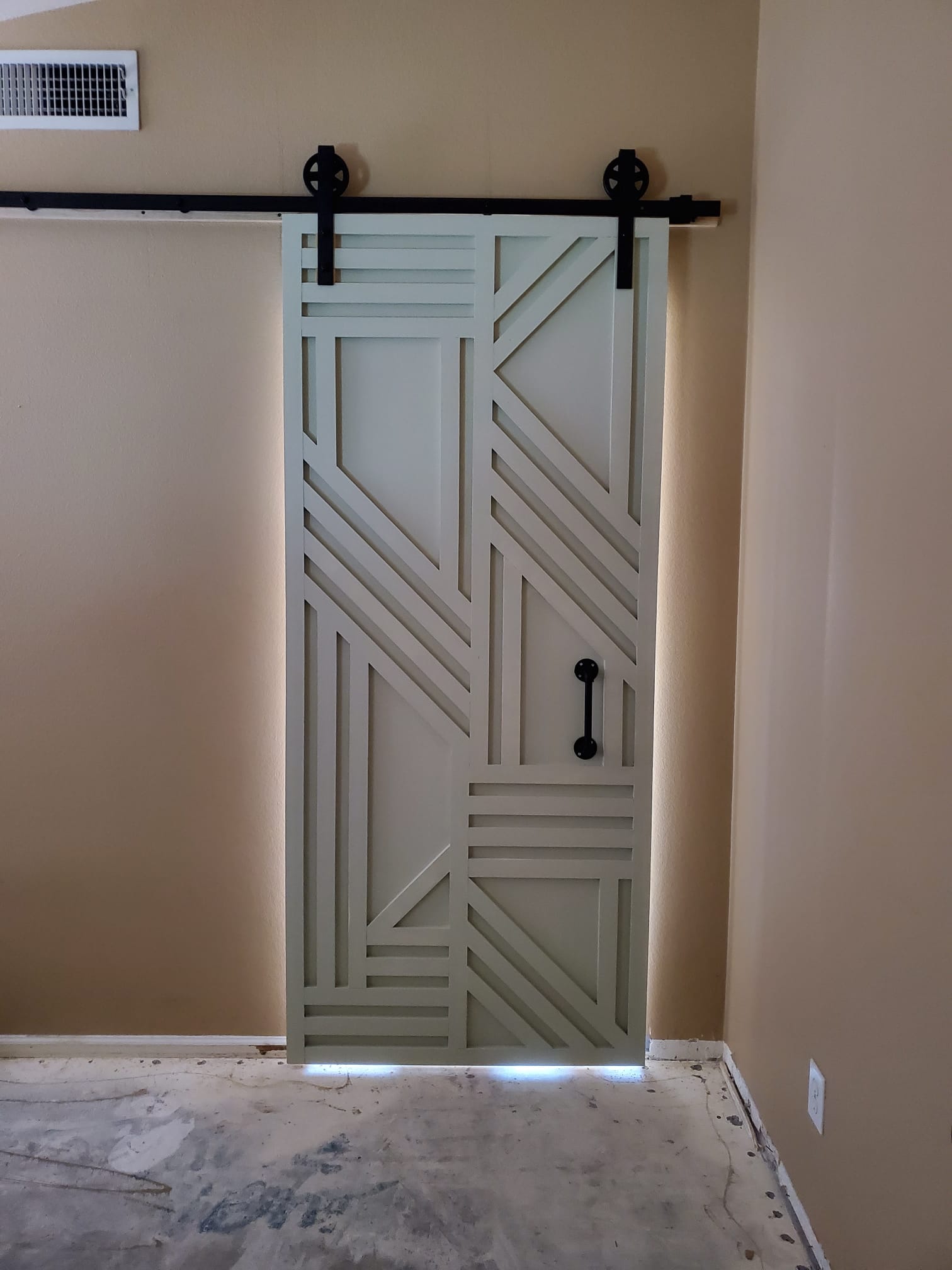
Supplies Needed
These are all the supplies we used.
Most we already owned and highly recommend owning if DIY home projects are your cup o’ tea.
If you are in the market, head to Home Depot in store or online this week for up to 20% off Memorial Day Savings!
- Tape measure
- Thick lead pencil
- Two sheets ¾ inch finished plywood (usually measures 96x48.5 inches)
- Table saw (but a handheld skill saw can work, if you have a steady hand)
- Ryobi miter saw
- Drill
- Box of 1-inch Philip screws
- 1 ½ inch spacers (to align all slats; either cut your own or use something you already have)
- Wood putty
- Putty knife or scraper
- Sanding sponge
- Paint tray
- Primer paint
- Quart of paint
- 2-inch paintbrush
- 4-inch smooth surface paint roller
- Stud finder (a simple one like this will do)
- 8 ft, 1”x2.5” board (if your rail’s main points aren’t drilling into studs)
- Door handle (I purchased this 11” black pipe handle)
- Ladder
- Sliding door rail kit (like this black, 8 foot barn door rail kit from Amazon)
- Socket wrench (approx. 15mm)
DIY Barn Door Overall Cost
Granted, lumber prices have soared since we initially purchased barn door materials. Even so, depending on the type of plywood you choose, you will still save money going the DIY route compared to buying retail.
At the time, a sheet of plywood was $57 (plus tax) at Home Depot. At most, it might be a little over $60 now. Not a huge difference.
We had scrap plywood from a prior project, so we only needed one sheet for the door. The extra remnants were used for the geometric slats.
The industrial style handle and matching black sliding door system came to about $100 total.
Since we are full-time DIYers these days, we owned all tools required. But don’t be afraid to rent, borrow (begging optional), or request Home Depot’s lumber associate to assist with cuts.
Again, I already had the wood putty, most paint supplies, and a leftover gallon of primer from when I painted my kitchen cabinets last year.
For $15, I chose a super light green shade from the same palette and swatch as my bedroom walls, but ordered only a quart in Behr’s Scuff Defense Interior Eggshell Enamel.
Overall, our cost for this DIY, geometric, sliding barn door came to $180.
To save you the math, that’s $400+ in savings! Even if it had only saved us $200, it would have been worthwhile.
Final Thoughts on Our Sliding Barn Door
I love seeing our DIY creations come to life!
Since our modern barn door is so big and visible from the main hall, it’s a dramatic statement piece for our bedroom. Who needs an art wall when you have a modern, geometric barn door?
However, I have yet to paint the backside. We were so eager to get it up that I didn’t really care what it would look like from the bathroom’s perspective. Not that it’s terrible—just bare plywood.
But I think I’m going to cover the flip side with black chalk paint. Even if we never actually use chalk on it, having a solid dark color will be a nice neutral to my colorful Portuguese-inspired, painted bathroom tile.
We'll also probably add a smaller handle on the backside as well, to discourage greasy fingerprints over time.
So, what’s your verdict? Will a DIY modern barn door be added to your list of home design upgrades?
Diagram
As promised, here is the detailed diagram, including a key for exact measurements.
All horizontal and diagonal cuts are measured from top lines while all vertical cuts are measured to the longest points.
The gaps between the geometric cuts are 1 1/2" apart.

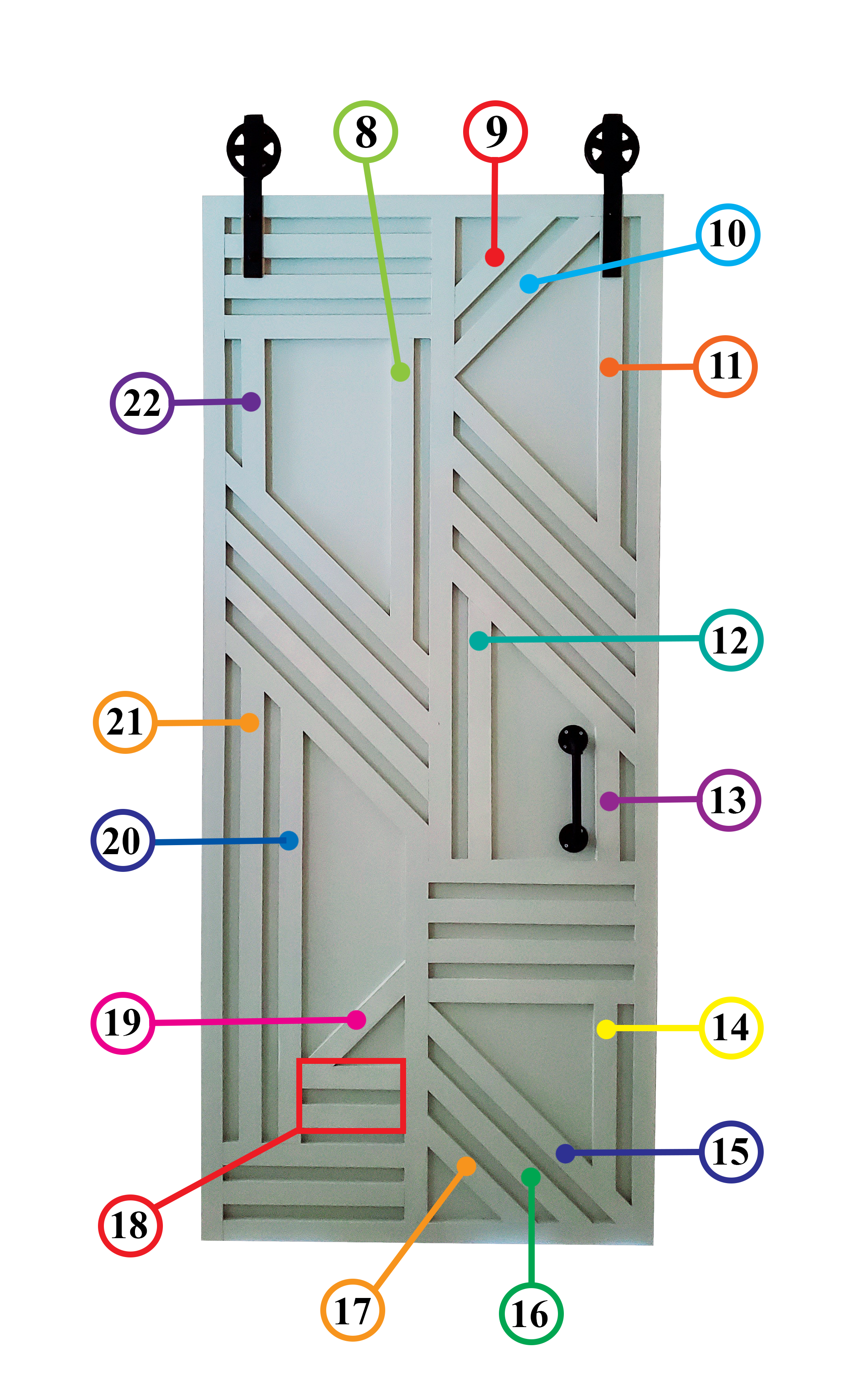
- 56"
- 18"
- 25 3/8"
- 22 3/4"
- 18"
- 16"
- 34 1/8"
- 26 3/8"
- 8 3/8"
- 15 1/4"
- 28 3/8"
- 23"
- 11 3/4"
- 16 5/8"
- 25 1/2"
- 20 3/4"
- 13 5/8"
- 9 1/8"
- 13"
- 38 1/4"
- 41 3/4"
- 22. 13 1/4"